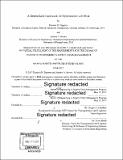A generalized framework for optimization with risk
Author(s)
Zipperer, Damaris R; Brown, Andrew N
DownloadFull printable version (10.09Mb)
Other Contributors
Massachusetts Institute of Technology. Supply Chain Management Program.
Advisor
Sergio A. Caballero.
Terms of use
Metadata
Show full item recordAbstract
Supply chains are facing increasingly volatile environments. Traditional optimization solutions provide a baseline understanding for industry applications, but cost-efficient solutions require a more robust approach. In high-tech capital construction projects, the construction of facilities requires complex project schedules, forecast well in advance. These forecasts are used to hire contract workers of varying contract lengths. In this thesis, we develop a risk integration methodology for contract workforce hiring optimization, and explore the capability of generalizing this approach for other supply chain problems. We first create a risk-integrated, optimal solution for workforce hiring that strategically covers areas of high risk density in construction forecasts. We first develop a program to simulate schedule variations based on the associated risk parameters of the scheduled tasks. Using the risk statistics resulting from these simulated schedules, we build new schedule requirements using two different methods. The first method addresses the gap from a daily perspective (bottom-up), while the second method addresses it from an overall schedule perspective (top-down). These new requirements are each overlaid on the input schedule, re-optimized, and excess daily coverage is trimmed. Using both methods, we found that higher levels of risk coverage were achieved at lower costs than the traditional solutions. In the studied case for Intel, a 23% additional risk coverage was generated for equivalent cost. Ultimately, the results show that strategic risk integration can result in a lower final cost, and a generalized framework for risk integration can be applied across many supply chain problems.
Description
Thesis: M. Eng. in Supply Chain Management, Massachusetts Institute of Technology, Supply Chain Management Program, 2017. Cataloged from PDF version of thesis. Includes bibliographical references (pages 51-52).
Date issued
2017Department
Massachusetts Institute of Technology. Supply Chain Management ProgramPublisher
Massachusetts Institute of Technology
Keywords
Supply Chain Management Program.